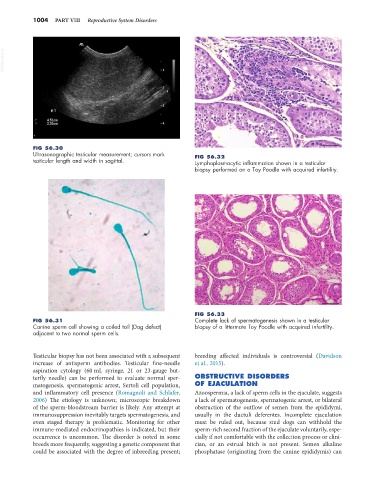Page 1032 - Small Animal Internal Medicine, 6th Edition
P. 1032
1004 PART VIII Reproductive System Disorders
VetBooks.ir
FIG 56.30
Ultrasonographic testicular measurement; cursors mark FIG 56.32
testicular length and width in sagittal. Lymphoplasmacytic inflammation shown in a testicular
biopsy performed on a Toy Poodle with acquired infertility.
FIG 56.33
FIG 56.31 Complete lack of spermatogenesis shown in a testicular
Canine sperm cell showing a coiled tail (Dag defect) biopsy of a littermate Toy Poodle with acquired infertility.
adjacent to two normal sperm cells.
Testicular biopsy has not been associated with a subsequent breeding affected individuals is controversial (Davidson
increase of antisperm antibodies. Testicular fine-needle et al., 2015).
aspiration cytology (60 mL syringe, 21 or 23-gauge but-
terfly needle) can be performed to evaluate normal sper- OBSTRUCTIVE DISORDERS
matogenesis, spermatogenic arrest, Sertoli cell population, OF EJACULATION
and inflammatory cell presence (Romagnoli and Schlafer, Azoospermia, a lack of sperm cells in the ejaculate, suggests
2006) The etiology is unknown; microscopic breakdown a lack of spermatogenesis, spermatogenic arrest, or bilateral
of the sperm-bloodstream barrier is likely. Any attempt at obstruction of the outflow of semen from the epididymi,
immunosuppression inevitably targets spermatogenesis, and usually in the ductuli deferentes. Incomplete ejaculation
even staged therapy is problematic. Monitoring for other must be ruled out, because stud dogs can withhold the
immune-mediated endocrinopathies is indicated, but their sperm-rich second fraction of the ejaculate voluntarily, espe-
occurrence is uncommon. The disorder is noted in some cially if not comfortable with the collection process or clini-
breeds more frequently, suggesting a genetic component that cian, or an estrual bitch is not present. Semen alkaline
could be associated with the degree of inbreeding present; phosphatase (originating from the canine epididymis) can

